When it comes to finding the perfect Pitbull, you’ve got a few options. There are actually a wide range of Pitbull breeds. To help you in your search for the perfect Pitbull pet, we’ve compiled a list of all the various types and their differences. These range from the classic American, to the rarer and more exotic Villaliberty and Chamuco bully. Unfortunately, this dog breed has acquired a bad reputation owing to their tragic history of being used as fighter dogs. We hope this list helps you see their breed in a better light and to understand that they are, truly, beautiful.
The Origin of The Name
The name “pit bull” doesn’t actually refer to a specific breed of dog (except for the American Pit Bull Terrier). It is actually used as a blanket term for several types of dogs that fit the category based on set characteristics.
The breed name originates from early 19th century British Isles, when “Bull Baiting” was created. This was a barbaric form of public entertainment involving a bull tied to an iron stake. The bull’s movement was limited to a 30-foot radius. Someone blew pepper into its nose to enrage it just before setting dogs upon it. This horrid sport was fortunately outlawed in 1835, but had birthed the term “pit bull” because the dogs that had been used for this sport were English bulldogs, which were later crossed with terriers.
Pitbull Characteristics
Pit Bulls come from a variety of breeds, as opposed to being one recognized breed. Recognized Pit Bulls possess a set number of characteristics connected to this breed of dog. Listed below are the characteristics you should expect to see in your bully breed.
What It Takes to be Recognized by the AKC
Though the American Kennel Club does recognize the Staffordshire Bull Terrier and the American Staffordshire Terrier, they do not, in fact, recognize any other Pitbull breeds. We believe this is because the standard Pitbull does not meet their specific requirements. Take a look:
- Geographic Distribution: They need to be located in 20 or more states.
- Population: A sufficient population of 300-400 dogs minimum with a three-generation pedigree. All dogs in the pedigree must be of the same breed.
- A Demonstrated Following: A minimum of 100 active household members need to show an interest in the breed, such as with a National Breed Club.
- Review: The AKC must review and approve the club’s constitution and by-laws as well as the club’s breed standard. AKC Field Staff must complete breed observations.
The Pitbull’s Timeline
Pit Bulls have had a wildly varied history, going from barbaric entertainment to the most beloved dog in America, and back again. Fortunately, their popularity has increased. More people are owning Pit Bulls and happy owners have advocated endlessly for the breed. For more details on their controversial past, check out this timeline below:
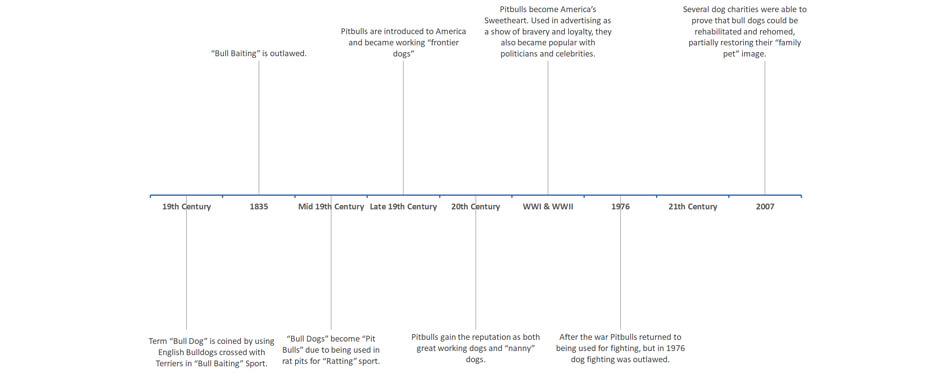
Types of Pit Bulls
There are four main breeds that everyone knows to be of the Pitbull variety. That’s just the start. There are many more dog breeds that fit into the Pitbull category that would be well worth considering for your new pet. Here’s a list of the top 15 bully breeds that could be a good fit for you and your family.
Staffordshire Pitbull Terrier
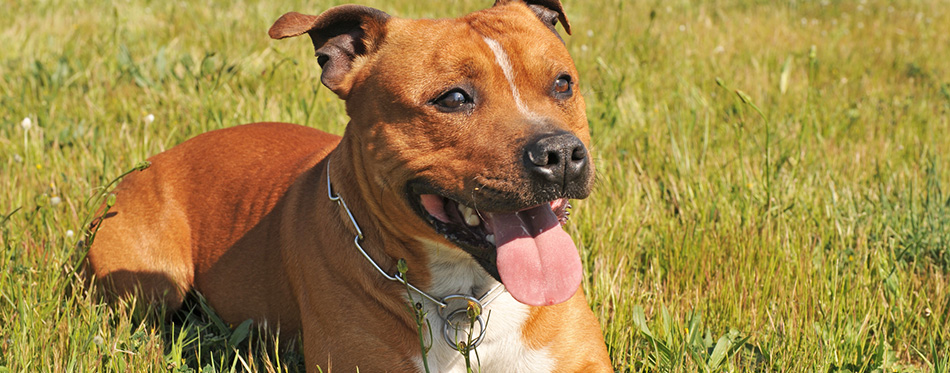
The Staffordshire Pitbull Terriers were once referred to as “Nanny Dogs” thanks to their renowned, kind natures. They are gentle around children and great in family environments. They are different from other Pit Bulls because their bloodline includes a small fraction of Collie, which softens their appearance and gives them a slightly lazier nature.
Despite their eagerness to please, Staffies (as they are affectionately known) need a strong hand to show them who’s Alpha of the pack. This dominance play must be done with confidence. Staffies possess strong personalities and can easily overrun owners if not checked at a young age. However, if their owner is too aggressive, that can also turn them the wrong way. Remember: An aggressive owner will create an aggressive Staffie, while a friendly-but-firm owner will have a dog that fits within the household perfectly and stays within their place.
Interesting Facts
- They are a great option for first-time owners, as they are eager to please and people-oriented.
- They are very intelligent dogs and therefore easy to train.
- They are extremely playful and require lots of attention.
- They suffer from separation anxiety, as they long to always be near their owners.
- They can become destructive when bored.
American Pitbull Terrier
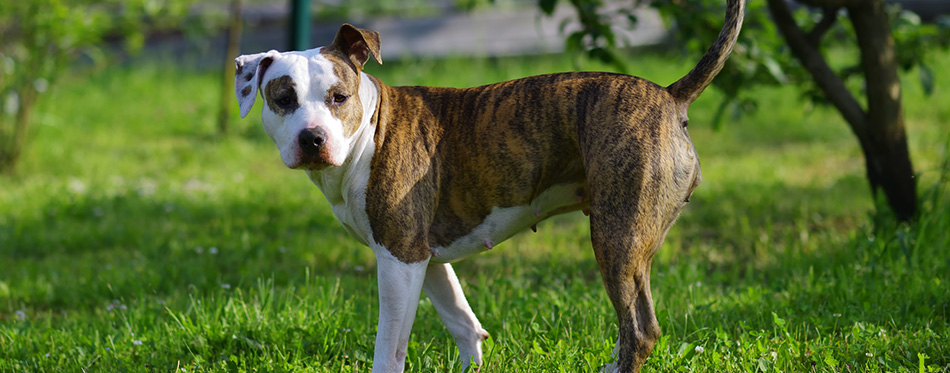
The American Pitbull Terrier is known for its fearlessness and easy-going nature. This breed has been banned in the U.K., thanks to the aforementioned dog-fighting practices, but remains a viable option for U.S. owners. This breed can still become a friendly family pet, if cared for properly. They have a high prey drive, which must be weaned out through effective training. They are very caring and loving toward children.
They are a very energetic breed that needs a lot of exercise and mental stimulation to keep them from acting out. This would come out primarily as aggression toward other dogs. However, an American Pitbull Terrier that has been treated well is unlikely to show any signs of this. As long as you keep them active and well-trained, American Pit Bulls make excellent pets. If you do not have a lot of spare time and can’t commit to your dog, the American Pitbull Terrier is probably not the best breed for you.
Interesting Facts
- Can weigh up to 90lbs.
- They are fearless and protective.
- Banned in the U.K. and New Zealand.
- The U.S. Army once used them as mascots.
- Used in multiple PR campaigns as the American Family Dog.
American Staffordshire Terrier
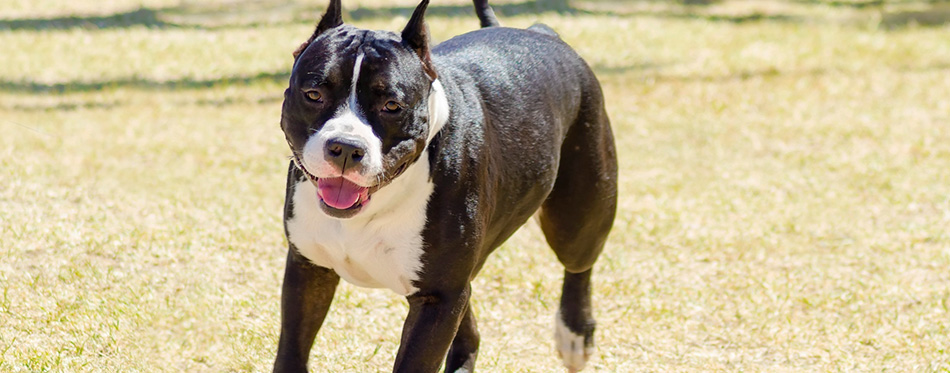
The American Staffordshire Terrier adds a little more height and agility to its otherwise crossed appearance between the American Bulldog and the Staffie. This breed is stocky and people-oriented. American Staffies do best when given a specific job. American Staffies require lots of training, particularly in obedience, to be fulfilled.
They are generally a low-maintenance breed, although they still need plenty of exercise (and love!). They are a confident breed, which can sometimes get out of hand if not trained properly. That said, they make for great companions and retain an eager-to-please quality. Finally, they make loving additions to any home.
Interesting Facts
- They are the heaviest breed out of the other three mentioned.
- They love to dig and chew.
- They make excellent guardians.
- They should always be bought from reputable breeders, as pedigrees can have many issues with their health.
- Unlike other Pitbull types, they commonly have their ears erect, and naturally pulled slightly back.
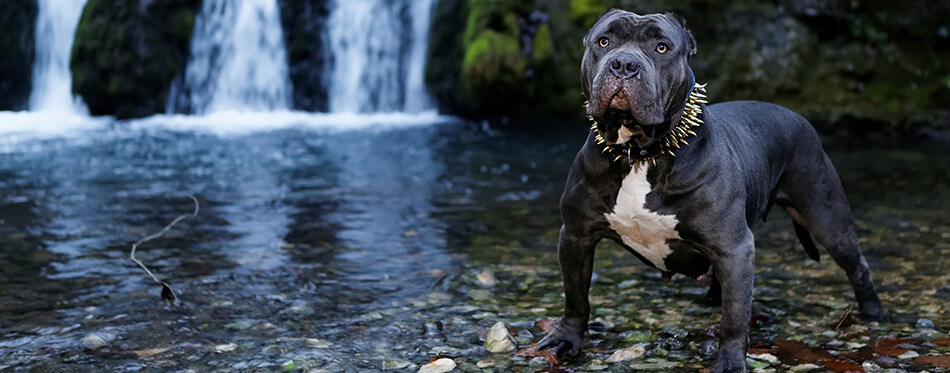
American Bully
This breed gets a special honorable mention! Though not a pure breed like the ones on our original list, the American bully combines 2 of our pitbull breeds and would still fall within the “pit bull” description.
The American Bully is a mix of the American Bulldog with the American Pit Bull Terrier and is a short, broad, powerful breed with a glossy coat and kind round eyes. They possess the stability and loyalty from their American Pit Bull Terrier heritage along with the loving, sociable, outgoing, and playful temperament of the American Bulldog. A perfect combination.
Breed Misidentification – Dogs That Look Like Pit Bulls
Though there is a brilliant range of Pit bulls you could pick as your new pet, there is also quite a list of breeds that share similar characteristics, but do not fall within the Pitbull category. These three specific dog breeds are generally larger than the Pitbull and classify instead as a “Working Group” breed. Read on them below!
Boxers: Boxers are a proud, powerful breed that is much loved for their work ethic and hunting ability throughout the United States. Boxers also carry many of the same personality traits as Pitbull types. They are fiercely protective of their family, but can become destructive when not exercised enough. Though boxers most commonly have a chestnut-colored coat, a boxer’s fur can also come out brindle, white, or multi-colored. Their coat variations likely add to the Boxer/Pitbull confusion, as many people are only used to seeing their chestnut coat.
Cane Corso: The Cane Corso, also known as an Italian Mastiff, is a large breed that falls under the Molosser category of dogs. It is a powerful dog that has historically been used for guarding and working, not unlike other breeds within the Molosser category. Its stocky, muscular build and short, sleek fur often is mistaken for a Pitbull. The Cane Corso is lacking in some of the key attributes of a Pitbull, such as their aloof personalities when it comes to strangers, as well as being much too large for a Pitbull breed. Head over to our review of dog food for Cane Corso for more options.
Dogo Argentino: The Dogo Argentino, as a rare breed, is mistaken for the Pitbull due to its boxy head and immensely muscular body. This breed is too large for your typical Pitbull and does not carry any history of dog fighting sports. They were originally bred as fierce guard dogs to hunt and kill wild boars, as well as mountain lions.
Things to Consider With a Pitbull Puppy
If you’re thinking of getting yourself a Pitbull puppy, you’ll want to know a thing or two about them first. American Pitbull Terriers and the Staffordshire Bull Terrier are two of the most desired bully breeds. They can, however, be difficult to raise if you don’t know what they need. This is also true of other bully breeds, but once you know what to look out for, you are sure to make both your lives much easier.
- They can be destructive: First and foremost, with almost every type of Pitbull, they are likely to become destructive during their teething phase. This trait is difficult to train out of them and requires a firm hand, patience, and plenty of replacement furniture.
- They require a lot of exercise: Almost all Pitbull breeds are high energy dogs. Though the Pitbull term fits several different breeds, they all tend to be working or ex-fighting dogs born with a lot of muscle. If not properly exercised, they will put their energy and muscles to use in a way that may cost you a new sofa, so be sure to get them out for a good, strong walk a couple of times a day.
- They are not suited to small apartments: Because of their massive amount of energy, they are best suited to homes that can provide a secure and spacious backyard. This gives them plenty of place to run and play so they don’t become restless.
- They will likely have a weak immune system: Many types of Pit Bulls are born with a weak immune system. This means that they are more likely to develop allergies and sensitivities that will need close monitoring.
- Raise them right: Pit Bulls have developed a bad reputation over the years owing to their unfortunately violent history. This, of course, was forced on them by Bull Baiting, ratting, and dog fighting, and the people that ran those horrid sports. This makes these dogs more a victim of their circumstance and a product of their environment. If you raise them with the same compassion and love as you would any other dog, they will love you a thousand-fold in return, and their nature will turn docile, gentle, and sweet.
You may also like our article on Dog Food for Pitbulls.
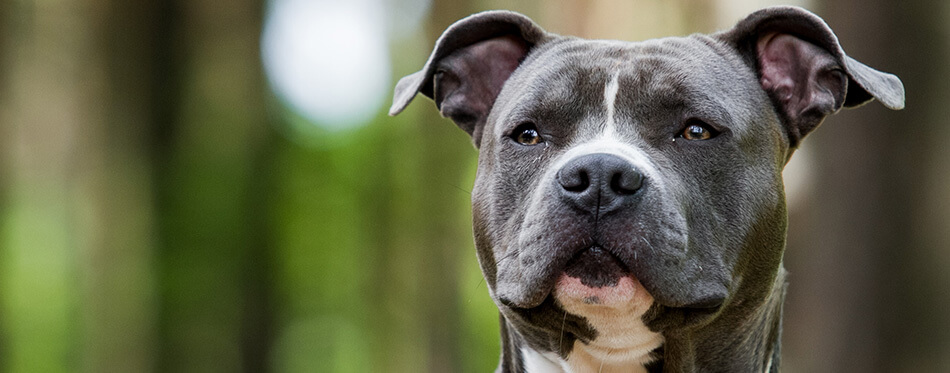
FAQs:
Q: How can I tell what breed my Pitbull is?
It can sometimes be difficult to tell the difference between what would be classed as a Pitbull, versus other mixed breeds. There are some medium-sized dogs that simply look like Pit Bulls. Here’s how to know which bully breed you have:
Weigh Your dog
If you have chosen to adopt an adult Pitbull, then it is most likely the American Pitbull or the Staffordshire Terrier. Still unsure how to tell the difference between them? Weighing them can be a helpful indicator. You will need to wait until your dog is a healthy size (such as if you have a rescue suffering from malnutrition), and weigh them to see which pound bracket they fall into.
Feel Their Coat
Generally speaking, all Pit Bulls have a similar coat. Most Pit Bulls have very short and smooth fur. This step may help you figure out if you have an American Pitbull Terrier, as they have noticeably thicker fur.
Look at Their Build
Each one of the Pitbull dogs has its own set of unique features that set them apart from other breeds. Once you learn to recognize some of their more defining features, you should be able to figure out which breed you have. The best way to familiarize yourself with the look of each of the bully breeds is to study images of them.
Q: Do Pit Bulls love their owners?
It seems an unusual question to ask about a dog, but as the Pitbull is burdened with a violent reputation, it is an understandable worry. Don’t fret, we’re here to help.
The answer is yes. A Pitbull will love and absolutely adore their owner. When you raise them right, Pit Bulls are gentle, sweet, cuddly, and loyal. Current owners’ supportive words are slowly but surely restoring their kind image and reputation.
As a highly intelligent breed, they learn quickly and train well (with a firm hand). They will love their family with everything they have. Pit Bulls originally had the nickname “nanny dog”, thanks to their gentle nature around children. As with any dog, though, this does not mean they should be left completely alone to watch a child. They aren’t actual nannies!
Q: What is the friendliest Pitbull breed?
Pit Bulls are truly wonderful dogs to have. Some have more boisterous personalities than others, which can be intimidating in such a powerful animal. If you’re looking for a Pitbull that would fit well within a casual home setting, the Razor Edge Pitbull, (despite its name), would make an excellent choice.
Contrary to our other breeds, the Razor Edge Pitbull was actually bred as a simple companion dog. They were never intended to fight or enter aggressive competitions. The traits of this beautiful medium-sized Pitbull were carefully selected from several different breeds within the Pitbull family to produce a pup with rock-solid temperament and a more docile nature. We’d certainly recommend this breed for those looking for the friendliest furball!
Q: How long do Pit Bulls live?
Equally important is a Pitbull’s lifespan, which ranges from 8-16 years. Their lifespan depends greatly on their environment, upbringing, and genetics. Pit Bulls have been known to live as old as 20, but these dogs are few and far between. It is also rare that Pit Bulls live less than five years.
It is essential you treat your dog well, providing them with good nutrition, plenty of exercise, and love. A dog’s mental health can affect its physical well-being just as much as it affects humans. For a more accurate idea of how long each breed can live, here are the current approximations connected to each one.
Q: Do Pit Bulls need a lot of attention?
To put it plainly, yes. Pit Bulls are highly affectionate dogs that benefit from a lot of attention. This isn’t to say that you need to give them your undivided attention at all times, but it is definitely worth taking the time each day to let them curl up with you, play around, and take a much-needed walk.
Their active nature makes them playful and boisterous. They possess a deep tank of energy, meaning they will need frequent walks at least a couple of times a day. You can help them release their energy by letting them race around the backyard, play fetch, and generally wear themselves out. Because of this boundless energy, they are not suited for small properties or apartments. They can become stressed and potentially destructive if not given the space to run and roam.
Q. Are Pit Bulls high maintenance?
Your Pitbull’s level of high maintenance depends on their breed type. If they do not suffer from any medical complications, then they are very low maintenance breeds to keep! For example, their short coats will never mat, require trimming, or even need brushing. Their coat doesn’t really retain bad odors, which means they would only need a bath once a month (provided that they don’t roll in something unpleasant on a walk). You’ll still want to trim their nails and make a point of cleaning their teeth regularly. This helps them retain general hygiene and avoid infection. Good nutrition is always key for healthy growth and a strong body.
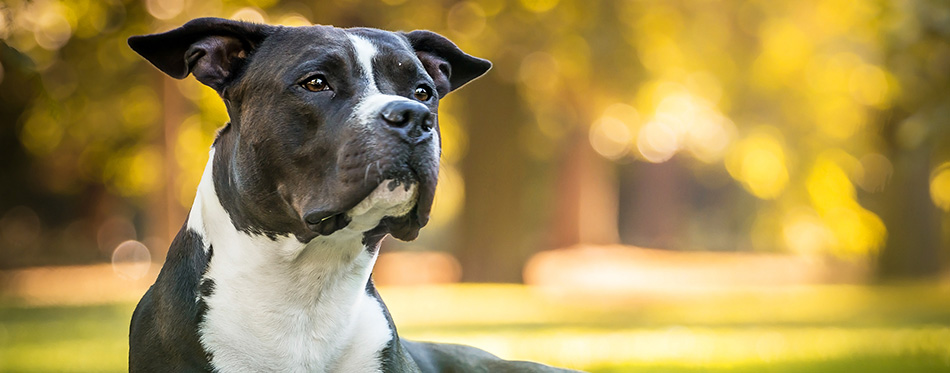
Q. What are the potential health problems for a Pitbull?
The general care of a Pitbull is very simple, though there are certain traits that can pop up in Pitbull breeds:
- Hip Dysplasia: A growing Pitbull pup should always be checked for signs of hip dysplasia. Hip dysplasia is an unfortunately common ailment for many large breeds. However, it can be rectified through physiotherapy, or in some more extreme cases, with surgery. It is worth noting that hip dysplasia can be exacerbated through excess weight. Make sure to watch your dog’s weight from the start! It would be a smart way to eliminate that from ever becoming an issue.
- Skin issues: Pit Bulls are prone to allergies, which can range from everyday grass, to factory-like pollen. Sometimes, it is simply the new carpet cleaner you’ve been using. Allergies are treatable with antihistamines, while any skin irritations are treatable with shampoos and ointments. If you are particularly worried about a reaction, don’t be afraid to call your vet.
- Knee Problems: Moreover, knee joint problems can be caused by excessive weight gain, much like hip dysplasia. Consequently, it is also something that can be the aftermath of an injury. This is certainly the most common cause of knee problems in Pitbulls, as they tend to run far faster than they should and act more boisterous than their bodies can handle. You can fix your pup’s knee problems using a simple brace and by reducing their exercise. Though it is best not to completely stop exercise. The brace should support their ligament until it heals. Moreover, if the dog is older or suffering from any other problem that could somehow prevent the ligament from healing, then a surgical solution may be the way to go.
Check out our guide on the Best Dog Knee Braces.
- Heart disease: In addition, the Pitbull is naturally susceptible to inborn heart defects. These include varied styles of Cardiopathy, as well as irregularities and valve malformations. Quite often these issues are only minor and could be left untreated in an otherwise healthy dog. Though it is also possible that older dogs or those with a weaker disposition may need medication.
- Obesity: A common issue Pitbull owners run into is obesity. Pit Bulls are such energetic dogs because they must continuously burn off calories to keep their body lean. Unfortunately, if you do not watch their caloric intake and exercise regime properly, they may start to gain too much weight. If you do find this happening, you can fix it easily by adjusting their diet.
Pit Bulls are a complex and beautiful breed with a tragic history. They deserve love as much as any other dog and to be treated with kindness. Figuring out what kind of Pitbull you have can get a little tricky. Hopefully, this article breakdown has helped you understand more about this iconic breed.

